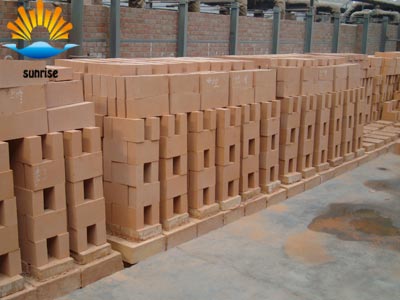Refractory dryness
Date:2017-12-04 16:01 From:Zhengzhou Sunrise Refractory Author:admin
The drying system is the sum of the conditions when the brick is dried. It includes drying time, temperature and relative humidity, the moisture before the brick is dry, and the residual moisture after the drying is finished.
1. Factors affecting the drying time
(1) the nature and structure of the material. For example, the drying time for a clay brick is related to the nature of the clay incorporated in the furnish and to the particle composition of the clinker added. The stronger the plasticity of the clay combined with the ingredients, the more the amount added, the finer the particle composition, the harder it is to dry.
(2) the shape and size of the brick. The larger the unit mass of brick, the more complicated the shape, the more dry it should be.
(3) The initial moisture content of the blank and residual moisture after drying.
(4) Drying medium temperature, humidity and flow rate.
(5) The temperature of the drying medium in the dryer. The smaller the temperature gradient, the higher the average temperature of the lower drying, the more uniform the drying process, and the drying time will be shortened accordingly. However, the higher the temperature of the dryer in the drying medium, the greater the heat consumption of the drying process.
(6) The structure of the dryer is good, the sealing condition and operating conditions also have a great influence on the drying time. The method of adjusting the drying process is to change the temperature, humidity, flow rate and drying time of the desiccant. The relationship between these parameters is also very complicated, so, for a variety of different products is experimentally determined to dry.
2. The dry residual moisture of the tile is determined by the following factors:
(1) brick mechanical strength should be able to meet the transport requirements of loading kiln;
(2) to meet the requirements of rapid heating in the early stages of firing;
(3) the size and thickness of the mountain product, etc., the residual moisture of the large and shaped products, which are usually complicated in shape, should be lower;
(4) Different types of firing kiln have different requirements.
- The second of the above factors has a special effect.
It is not necessary to have too much residual moisture, because draining the last part of the moisture is not only economically unfriendly to the dryer, but also the overdrying of the brick due to its brittleness makes it difficult to transport and load the kiln. Semi-dry pressed clay brick firing tunnel kiln, the residual moisture should be less than 2% -3%, firing in other kilns to be less than 4% -5%. Before drying the silica brick requires drying to 1% -2%, magnesia brick 0.6% to 1.0%.
Second billet firing
High-temperature calcining is essential in the production of refractory materials, even for increasingly unshaped refractory materials. The above materials in the production process without firing process, but the aggregate is still calcined from the clinker, and the month - refractories in the course of use, but also town as a calcination process.
The firing of the green body is the last step in the production of refractory materials. A series of physicochemical changes occur in the product during sintering. With these changes, the porosity decreases and the bulk density increases, so that the green body becomes a product with a certain size, shape and structural strength. In addition, by a series of physicochemical changes during firing, stable structures and mineral phases are formed, with various properties that are required for the article under different conditions. For example, refractory products used under the same temperature conditions have different requirements on corrosion resistance and thermal shock resistance. In addition to the process conditions such as selection of raw materials, particle compositions and molding density, the refractory products can be completely adjusted by firing Diao; the same organizational structure. The former to burn close to the theoretical density

